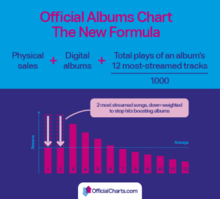Album-equivalent unit

Album-equivalent unit is a term in the music industry to indicate the consumption of music which equals the purchase of one album copy.[1][2] This consumption includes streaming and song downloads, in addition to album sales. Album-equivalent unit was incorporated into record chart methodology following the decline of album sales in the 21st century. Album sales more than halved from 1999 to 2009, declining from a $14.6 to $6.3 billion industry.[3] For instance, the only albums that went platinum in the United States in 2014 were the Frozen soundtrack and Taylor Swift's 1989, whereas several artists did in 2013.[4][5] The usage of album-equivalent units revolutionized the charts from the "best-selling albums" ranking into the "most popular albums" ranking.[6]
Beginning with the December 13, 2014 issue, the Billboard 200 albums chart revised its ranking methodology with album-equivalent unit instead of pure album sales. With this overhaul, the Billboard 200 includes on-demand streaming and digital track sales (as measured by Nielsen SoundScan) by way of a new algorithm, utilizing data from all of the major on-demand audio subscription services including Spotify, Beats Music, Google Play and Xbox Music. Known as TEA (track equivalent album) and SEA (streaming equivalent album), 10 song sales or 1,500 song streams from an album are treated as equivalent to one purchase of the album. Billboard continues to publish a pure album sales chart, called Top Album Sales, that maintains the traditional Billboard 200 methodology, based exclusively on SoundScan's sales data.[2] Taylor Swift's 1989 was the first album to top the chart with this new methodology, generating 339,000 album-equivalent units (281,000 units came from pure album sales).[1][7] On the February 8, 2015 issue, Now That's What I Call Music! 53 became the first album in history to miss the top position of the Billboard 200 despite being the best-selling album of the week.[8]
In the United Kingdom, the Official Charts Company has included streaming into the UK Albums Chart since March 2015.[9] The change was decided after the massive growth of streaming; the number of tracks streamed in the UK in a year doubled from 7.5 billion in 2013 to just under 15 billion in 2014. Under the new methodology, Official Charts Company takes the 12 most-streamed tracks from an album, with the top two songs being given lesser weight so that the figure will reflect the popularity of the album as a whole rather than of one or two successful singles. The adjusted total is divided by 1000 and added to the album sales figure.[10] Sam Smith's In the Lonely Hour was the first album to top the chart with this rule. Out of its 41,000 album-equivalent units, 2,900 units came from streaming and the rest were pure sales.[9]
In Germany, streaming began to be included on the albums chart since February 2016. Nevertheless, German Albums Chart is used to ranking the albums based on weekly revenue, instead of units. Hence, only paid streaming is counted and should be played at least 30 seconds. At least 6 tracks of one album have to be streamed to make streams count for the album, with 12 tracks being the maximum counted. Similar to the UK chart rule, the actual streams of the top-two songs are not counted, but instead the average of the following tracks.[11][12]
See also
References
- 1 2 "Taylor Swift's '1989' Returns to No. 1 on Revamped Billboard 200". billboard.com. Retrieved 1 July 2016.
- 1 2 Trust, Gary (2014-11-20). "Billboard 200 Makeover: Album Chart to Incorporate Streams & Track Sales". Billboard. Retrieved 2014-11-20.
- ↑ "Why Album Sales Are Down". Speeli. Retrieved 22 June 2015.
- ↑ McIntyre, Hugh (October 16, 2014). "Not One Artist's Album Has Gone Platinum In 2014". Forbes. Forbes, Inc.
- ↑ Sanders, Sam. "Taylor Swift, Platinum Party of One". NPR.
- ↑ Caulfield, Keith (May 22, 2016). "Drake's 'Views' Rules at No. 1 for Fifth Week on Billboard 200 Chart". Billboard. Retrieved July 2, 2016.
- ↑ "Why Is Taylor Swift Still #1?". pitchfork.com. Retrieved 1 July 2016.
- ↑ Book, Ryan (February 12, 2015). "Now 53 Outsells Taylor Swift, Becomes First Record to Top Albums Chart but Not Billboard 200; Kid Ink Cracks Top 10". The Music Times. Retrieved July 2, 2016.
- 1 2 "Sam Smith's 'In the Lonely Hour' Tops Historic U.K. Albums Chart". billboard.com. Retrieved 1 July 2016.
- ↑ "Official Albums Chart to include streaming data for first time". officialcharts.com. Retrieved 1 July 2016.
- ↑ "Deutsche Album-Charts integrieren Premium-Streaming" (in German). Musikmarkt.de. February 1, 2016. Retrieved 1 July 2016.
- ↑ Briegleb, Volker (February 1, 2016). "Deutsche Album-Charts jetzt auch mit Streaming-Zahlen". Heinz Heise. Retrieved 1 July 2016.